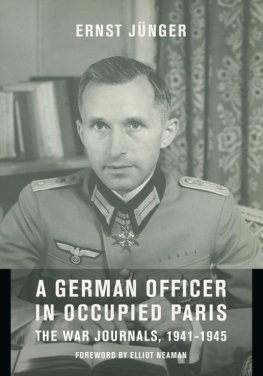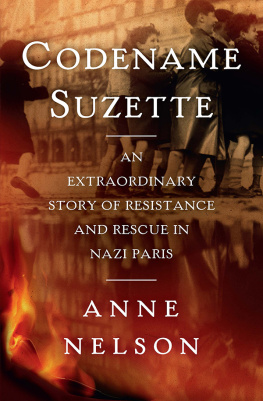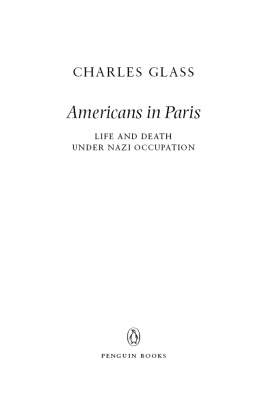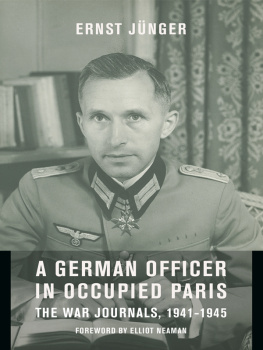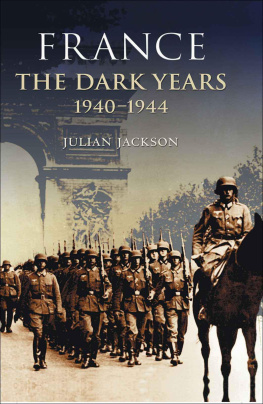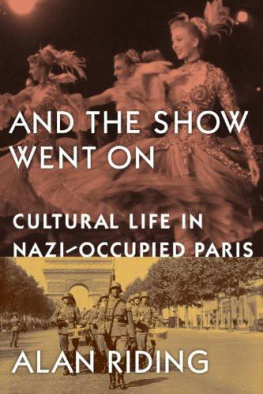ARTISTS IN
NAZI-OCCUPIED FRANCE:
A GERMAN OFFICERS MEMOIR
ARTISTS IN
NAZI-OCCUPIED
FRANCE:
A GERMAN OF-FICERS MEMOIR
WERNER LANGE
TRANSLATED BY LEONARD ROSMARIN

Library and Archives Canada Cataloguing in Publication
Lange, Werner, 1911-1980?
[Artistes en France sous lOccupation. English]
Artists in Nazi-occupied France : a German officers memoir
/ Werner Lange.
Translation of: Les artistes en France sous lOccupation.
Includes bibliographical references and index.
Issued in print and electronic formats.
ISBN 978-1-77161-330-9 (softcover).--ISBN 978-1-77161-330-9
(softcover).--ISBN 978-1-77161-331-6 (HTML).--ISBN 978-1-77161-332-3
(PDF).--ISBN 978-1-77161-374-3 (Kindle)
1. Artists--France--History--20th century. 2. France-
Intellectual life--20th century. 3. France--History--German
occupation, 1940-1945--Personal narratives, German. I. Title.
II. Title: Artistes en France sous lOccupation. English
| N6848.L3613 2018 | 709.4409044 | C2018-903081-X
C2018-903082-8 |
No part of this book may be reproduced or transmitted in any form, by any means, electronic or mechanical, including photocopying and recording, information storage and retrieval systems, without permission in writing from the publisher, except by a reviewer who may quote a brief passage in a review.
Published by Mosaic Press, Oakville, Ontario, Canada, 2018.
MOSAIC PRESS, Publishers
Copyright 2015 Groupe Artge ditions du Rocher - 28, rue Comte Flix Gastaldi - BP 521 - 98015 Monaco www.editionsdurocher.fr
Translation Copyright 2018 Mosaic Press & Leonard Rosmarin
Design by Courtney Blok
Printed and Bound in Canada

We acknowledge the Ontario Arts Council for
their support of our publishing program
We acknowledge the Ontario Media Development Corporation
for their support of our publishing program

MOSAIC PRESS
1252 Speers Road, Units 1 & 2
Oakville, Ontario L6L 5N9
phone: (905) 825-2130
TABLE OF CONTENTS
PREFACE
W erner Lange wrote these memoirs before hanging himself.
These are not classic war memoirs, nor are they even memoirs of the Paris Occupation in the way we imagine them. One does not find here either military activity, struggles against Resistant fighters, terrorist attacks, or persecution of Jews. The author is an intellectual, he is a subtle, cultivated Francophile. The people who file past us are arts personalities, painting and sculpture geniuses whose works take their places among the treasures of the great museums, and are found in the most prestigious collections. Their names appear in all the textbooks of art history. I will not quote them here, you will discover them in the following pages, and in positions that were not always flattering. Not because of any despicable conduct or criminal political activities, but because they tried to live normally when normality was out of the question, to even acquire wealth in some cases at a time when the Nazi occupier laid down the law.
Collaborators. collaborators who painted, sculpted, exhibited, had dealings with the occupier in order to continue painting, exhibiting, earning money, and, for some, eating better.
The interest of this text, indeed, its fascinating side, lies precisely in its frank, almost naive descriptions of everyday life. The war and the Occupation are there, but evoked from the vantage point of the restrictions, troubles, difficulties in moving about and finding gasoline, the problems that artists faced in obtaining the colours they needed to paint or the metals they required to cast their sculptures.
Books have already been written about the artistic life in the Paris of that time. We know that it was rich, productive and fruitful. Great films were made between 1940 and 1944, masterpieces like Les enfants du paradis (Children of Paradise) by Marcel Carn or Les Corbeaux (The Crows) by Henri-Georges Clouzot. Jean Cocteau, Sacha Guitry, Jean-Paul Sartre filled theatre halls. Music, painting, opera: the artistic effervescence was evident in all the domains of art.
The captivating quality of these pages lies not in the description of events that people who are interested in this period of history know already, and that one can find in other works, but in the anecdotal, everyday, banal nature of the lives these celebrities led under the occupation. It is precisely this indecent, almost people aspect that makes the book so unique and interesting. The fact that these events were related by an officer of the Propagandastaffel (Propaganda Squadron), but a young man full of admiration for the artistic luminaries he had to deal with, whom he had to take care of, gives the narrative an incomparable colour. The genuine friendship that linked Lange to Maillol or Vlaminck, his close relationships with Derain and others, gave rise to previously unpublished material of a richness that no history book can lay claim to.
After the end of the war, Werner Lange moved back to Paris as soon as it was possible, because he loved the arts and loved France. He continued frequenting the people he had known during the war. And if he committed suicide, it was not caused by issues connected to the time of the Occupation. It resulted from a love affair. In any event this is what they told me. These photos and this text written directly in French and which he never attempted to publish while he was alive, thus came naturally into the possession of his friend A.C., a well known figure of Parisian night life in the 70s and 80s and owner of gay establishments. To offset financial difficulties, he sold them to M.C., a renowned Russian painter and sculptor and well-informed collector living in France and the United States. A friend. So the Dr. Lange dossier lay dormant in one of his cupboards until October 2014. It was removed from that place following a conversation about Dina Vierny, herself a Russian migr and a famous gallery owner as well as Maillols inspiration, muse and heiress. And a character in this book.
So the text fell into my hands a bit like in the Manuscit trouv Saragosse (The Manuscript Found in Saragossa),, or rather in an improbable Un Allemand Paris (A German in Paris). Because the dandy side of Lieutenant Lange, his friendly and even at times schoolgirl side, makes this narrative unique and engaging in a paradoxical way. It is unique through the exclusive nature, if I may call it, of the stories he tells, because the private episodes related here (there is practically nothing else) possess an intimate quality owing to the fact that Werner Lange was the only one present there. He alone accompanied Arno Breker on his solitary trip across France. He alone dined with Picasso in a black market clandestine brothel. He alone travelled to Banyuls to convince Maillol to come to Paris for the inauguration of the big Breker exhibit. He alone would spend Sundays at the Vlamincks and Utrillos. He alone received spontaneous gifts from French artists that were destined for Joseph Goebbels. He alone saved Dina Vierny almost by accident from the claws of the Gestapo.
The many previously unpublished episodes of this book thus stand out through their astonishingly private nature, their singular psychological veracity. It is as though one were living next to these great artists and gallery owners; as though one were strolling with them on the streets of an occupied but so lively Paris, a city that has not stopped fascinating us seventy years after the end of the war.
Next page

